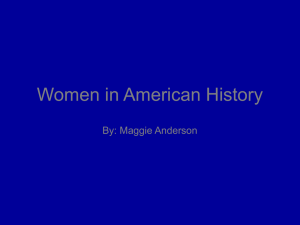Elizabeth Cady Stanton Women's Rights Leader, Suffragist, Reformer
advertisement
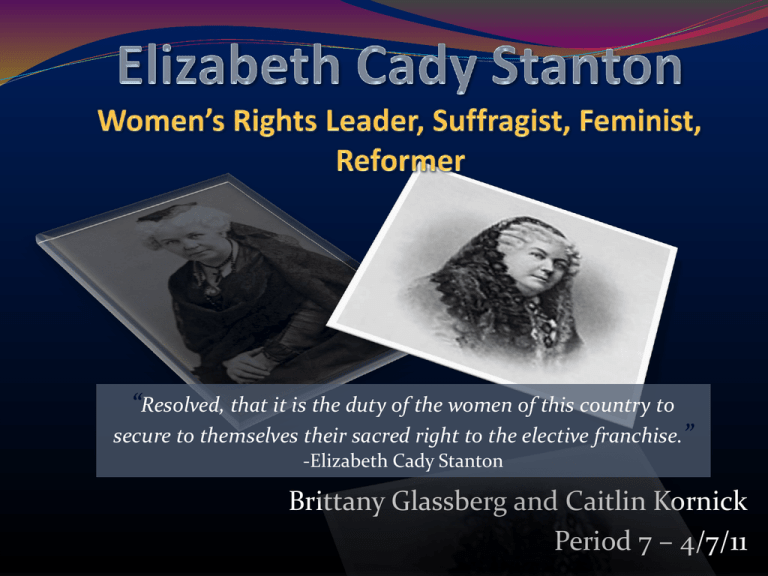
“Resolved, that it is the duty of the women of this country to secure to themselves their sacred right to the elective franchise.” -Elizabeth Cady Stanton Brittany Glassberg and Caitlin Kornick Period 7 – 4/7/11 A video will begin shortly “Oh, my daughter, I wish you were a boy” –Daniel Cady Born November 12th, 1815, in Johnstown, New York Daughter of Margaret Livingston and Daniel Cady, a lawyer and congressman, and later a judge. Family consisted of five daughters and five sons, but none of the boys survived. Graduated from Johnstown Academy and Emma Willard’s Troy Female Seminary. Married Henry Stanton, a lawyer and abolitionist, in 1840. Attended the World Anti-Slavery Convention in 1840, where she met Lucretia Mott. Worked with Susan B. Anthony for much of her life, forming the National Woman’s Suffrage Association. Helped to organize the convention at Seneca Falls, NY, in 1848, which was where she lived. Became president of the National Woman Suffrage Association She had a total of seven children. She died October 26, 1902. Elizabeth Cady Stanton with her daughter, Harriot Woman Suffrage the right of women by law to vote in national and local elections. The first women’s rights convention was held at Seneca Falls in 1848, beginning the woman suffrage movement. Those involved in the movement often worked with abolitionists up until the civil war. (Stanton and Anthony formed the National Woman's Loyal League in 1861) The movement split into the NWSA, led by Stanton and Anthony, and the AWSA, led by Lucy Stone, in 1869. The two organizations reunited in 1890 to form the NAWSA. Carrie Chapman Catt and NAWSA pushed for Women’s suffrage amendments at the state and federal levels. Alice Paul and Lucy Burns formed the more radical National Woman's Party in 1917. August 26, 1920, the Nineteenth Amendment was ratified and added to the U.S. Constitution, giving women the right to vote. "We are persons; native, free-born citizens; property-holders, tax-payers, yet we are denied the exercise of our right to the elective franchise . . . ” –Elizabeth Cady Stanton, Address to the Legislature of New York, February 14th, 1854. She and Lucretia Mott organized the Seneca Falls Convention in 1848, the first women’s rights convention. She spoke before the Legislation of New York February 14th, 1854, on the rights of married women. Became the first woman to run for Congress in 1866. Formed the National Woman Suffrage Association (NWSA) in 1869 with Susan B. Anthony. She served as its first president, until 1890. Was the coeditor of The Revolution, a women’s rights newspaper. Above (left to right): Elizabeth Cady Stanton, Susan B. Anthony, and Lucretia Mott, the leading figures in the early women’s rights movement. “She can own nothing, sell nothing. She has no right even to the wages she earns; her person, her time, her services are the property of another…” - “Address to the Legislature of New York,” Feb. 14, 1854 “If we consider her as a citizen, as a member of a great nation, she must have the same rights as all other members, according to the fundamental principles of our government.” - “The Solitude of Self,” spoken before the Judiciary Committee of the U.S. house of Representatives, Jan. 17, 1892 “Now is the golden time to work! Before another Constitutional Convention be called, see to it that the public sentiment of this state shall demand suffrage for woman!” - “Appeal and Petition Circulated in the State of New York,” 1859 One of Stanton’s greatest strategies in campaigning for women’s rights was writing. She often wrote speeches that were given by Susan B. Anthony. Her works include: Declaration of Sentiments (1848) The Woman’s Bible (c. 1895) History of Woman Suffrage (First volume-1881) The Solitude of Self (1892) Address to the Legislature of New York (1854) Many editorials for The Revolution Declaration of the Rights of Women “Resolved, that the speed success of our cause depends upon the zealous and untiring efforts of both men and women, for the overthrow of the monopoly of the pulpit, and for the securing to women an equal participation with men in the various trades, profession, and commerce.” –Elizabeth Cady Stanton Written by Elizabeth Cady Stanton Modeled after the Declaration of Independence Includes twelve resolutions on the equality of women Accuses men: “He has never permitted her to exercise her to exercise her inalienable right to the elective franchise” Presented on July 19th, 1848, at the Seneca Falls Convention. Had the support of influential people that included Lucretia Mott and Frederick Douglass. “We hold these truths to be self-evident: that all men and women are created equal” The convention was held on July 19 and 20, 1848, in Seneca Falls, New York, the home of Stanton. The Seneca Falls Convention began the Women’s Suffrage movement: Elizabeth Cady Stanton read her Declaration of Sentiments. The ninth resolution demanded the right for women to vote. It was the most controversial aspect of the convention. Began the movement that would eventually lead to the nineteenth amendment being passed in 1919. After the civil war, with the issue of suffrage for African American men being a concern, many wanted to postpone the woman suffrage movement. The Revolution, with Stanton becoming the editor in 1968, kept the women’s rights movement going. Stanton wrote many editorials, helping to voice the opinions of NWSA and discuss topics such as divorce. Elizabeth Cady Stanton and Susan B. Anthony The National Woman Suffrage Association Founded by Stanton and Anthony in 1869, Stanton was named president. Split from the American Woman Suffrage Association over issues such as suffrage for African American men, being the more radical of the two. Made the right for women to vote a priority, as well as marriage and divorce rights. Stanton had the organization work for an amendment to the Constitution. Went on to rejoin with AWSA. Stanton was named president. The resulting group, NAWSA, continued to fight for Woman Suffrage until 1920. Elizabeth Cady Stanton (seated) and Susan B. Anthony The Declaration of Rights and Sentiments and the Seneca Falls Convention began the Women’s Rights movement The NWSA continued to push for women’s rights with the leadership of Stanton and Anthony. The NAWSA would eventually help the nineteenth amendment pass. Stanton’s writing, including that in The Revolution, helped to make women’s rights an important issue, even after the civil war. Stanton’s work, and that of many others, ultimately resulted in women gaining more rights, especially the right to vote. Stanton, Elizabeth Cady, and Lucretia Mott. "'Declaration of Rights and Sentiments'." From: Documents of American History, Vol. I, ed. Henry Steele Commager, Milton Center, p. 315- 317. . American Women's History Online. Facts On File, Inc. Web. 10 Apr. 2011. <http://www.fofweb.com/activelink2.asp? ItemID=WE42&iPin=awhm0695&SingleRecord=True>. Stanton, Elizabeth Cady. "Appeal and Petition Circulated in the State of New York." From: Elizabeth Frost and Kathryn Cullen-DuPont. Women's Suffrage in America: An Eyewitness History. New York, NY: Facts On File, Inc., 1992. American Women's History Online. Facts On File, Inc. Web. 10 Apr. 2011. <http://www.fofweb.com/activelink2.asp? ItemID=WE42&iPin=AWHD0015&SingleRecord=True>. Stanton, Elizabeth Cady. "The Solitude of Self ." Judiciary Committee of the U.S. House of Representatives . 17 Jan. 1892 . Encyclopedia Britannica Online School Edition . Web. 10 Apr. 2011. < http://school.eb.com/eb/article-9404094>. Stanton, Elizabeth Cady. "Address to the Legislature of New York." From: Library of Congress. Rare Book and Special Collections Division. National American Woman Suffrage Association Collection. American Women's History Online. Facts On File, Inc. Web. 10 Apr. 2011. <http://www.fofweb.com/activelink2.asp? ItemID=WE42&iPin=awhm0686&SingleRecord=True>. “National Woman Suffrage Association" Encyclopædia Britannica. Encyclopædia Britannica Online School Edition. Encyclopædia Britannica, 2011. Web. 10 Apr. 2011. <http://school.eb.com/eb/article-9125026>. "Stanton, Elizabeth Cady" Encyclopædia Britannica. Encyclopædia Britannica Online School Edition. Encyclopædia Britannica, 2011. Web. 10 Apr. 2011. <http://school.eb.com/eb/article-9069429>. "Voting and Registration in the Election of November 2008." U.S. Census Bureau . N.p., May 2010 . Web. 10 Apr. 2011. <http://www.census.gov/prod/2010pubs/p20-562.pdf>. "Today in History: November 12. Elizabeth Cady Stanton ." American Memory . The Library of Congress , n.d. Web. 10 Apr. 2011. <http://lcweb2.loc.gov/ammem/today/nov12.html>. Portrait Monument to Lucretia Mott, Elizabeth Cady Stanton and Susan B. Anthony. Architect of the Capitol , n.d. Web. 10 Apr. 2011. <http://www.aoc.gov/cc/art/rotunda/suffrage.cfm>. "Elizabeth Cady Stanton ." National Park Service . U.S. Department of the Interior , 15 Sept. 2010 . Web. 10 Apr. 2011. <http://www.nps.gov/wori/historyculture/elizabeth-cady-stanton.htm>. Cullen-DuPont, Kathryn. "Stanton, Elizabeth Cady." Encyclopedia of Women's History in America, Second Edition. New York: Facts On File, Inc., 2000. American Women's History Online. Facts On File, Inc. Web. 10 Apr. 2011. <http://www.fofweb.com/activelink2.asp? ItemID=WE42&iPin=awhm0389&SingleRecord=True>.

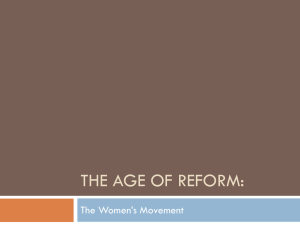
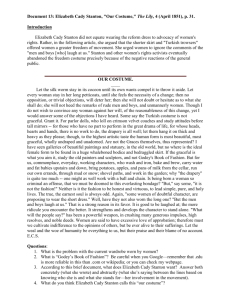
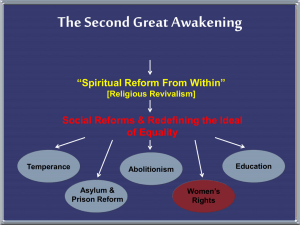
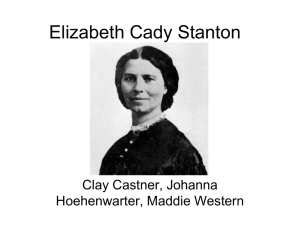
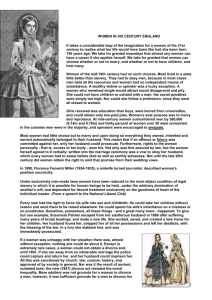
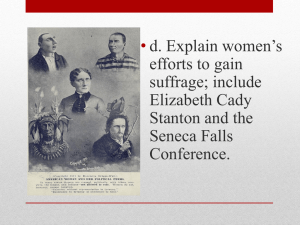
![womens_rights[1]](http://s2.studylib.net/store/data/010014890_1-dbb1785f178ee376274698e7007ca41f-300x300.png)
